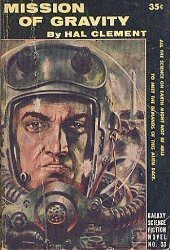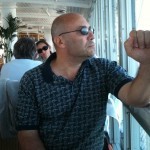Mission of Gravity – Hal Clement

 Hal Clement, also known as Harry Clement Stubbs, was born in Somerville, Massachusetts, in 1922 and published his first science fiction story in Astounding Science Fiction in 1942, a year before graduating in astronomy.
Hal Clement, also known as Harry Clement Stubbs, was born in Somerville, Massachusetts, in 1922 and published his first science fiction story in Astounding Science Fiction in 1942, a year before graduating in astronomy.
After serving as a USAF bomber pilot, with 35 missions over the Nazi Germany, Clement remained in the Air Force as a teacher of astronomy and chemistry at the Milton Academy.
Under the pseudonym George Richard he also produced a number of astronomical illustrations, but his fame is tied to science fiction, and has been awarded, in 1998, the title of Grand Master.
He left us in 2003.
As a writer, Hal Clement has had a great influence over the evolution science fiction, his numerous works have opened a path followed by many: Mission of Gravity is the novel that marks a milestone in his career and in hard science fiction.
is the novel that marks a milestone in his career and in hard science fiction.
Barlennan, brave captain of the vessel “Oceanic”, came into contact with alien visitors, and is now communicating with them, after having brought his ship near the equator, a secluded and little known place but dangerous.
The seas routes traveled by Barlennan are not composed of water, and the commander is very different from any of the terrestrial explorers. Barlennan is a species of an armored arthropod, fifty centimeters long, forged by the terrible living conditions of Mesklin, a planet of an enormous size, with a gravity at the poles of about 700g and a very short rotation period, so much so that one day only lasts about twenty minutes, and the surface is swept by hurricanes of unimaginable violence.
In the story, the aliens are human, cosmonauts whose ship can land and get off the planet only near the equator, where the centrifugal force due to gravity is “only” 3g, and to survive on the surface they have to wear pressure suits.
The human scientific mission has lost control of a probe of the value of two billion dollars, and is unable to recover it since this is has landed on the south pole of the planet. This is why the humans think of using the aid of Barlennan.
Thus begins a fantastic recovery expedition which sees mesklinians and humans work together to face and overcome the dangers that stand between them and their mission.
Thanks to a remarkable scientific preparation, Clement has built the planet Mesklin out of fantasy, sure, but the world and its biosphere is consistent with scientific knowledge.
How this giant of the skies was born is described by the author himself in the afterword of the novel, a short but extremely interesting article entitled The Spinning Top World, in Clement explains how the discovery of an astral body in the dual system of 61 Cygni has been the starting point for the construction of his Mesklin.
Once fixed in a scientifically plausible way, the characteristics of the planet enabled Clement to set the plot and the characters’ psychology: on Mesklin, concepts such as flying and flying objects are nonsense, and the fear of falling is for all mesklinians a real nightmare.
The author, however, does not travel all the way into the different, alien mesklinian mentality: the inhabitants of the planet adapt too quickly to new ideas, e.g., see the scene in which they try to carry Lackland, the human astronaut, over an iron plate, and the “intellectual convergence” between mesklinians and humans sounds a bit ‘forced'; despite all this, Barlennan remains — after more than half a century — one of the most remarkable aliens in the history of science fiction.
Some of the explanations in the history are a bit too long, and the story would have probably gained much verve from an “à la Jack Vance” approach, author traditionally not too focused on scientific verisimilitude, but I assume that Clement has worried more than it was necessary to make the reader understand the strange conditions of its creation rather than carrying the reader from a plot twist to another.
With little doubt, this is the most important work of Clement, and prototype for dozens of worlds built — in science fiction stories — with a rigorous logic, with the structure of a plausible ecosystem, and as a scientific possibility.
The novel is at half-way between those who prefer action-driven adventures with little pauses — for whom the novel will not be considered a masterpiece — and those who prefer hard science fiction, with rigorous scientific aspects of the story, and little space for fantasy and pseudo-magic-science.
Those who have read and liked other Clement’s stories, will love this novel, and maybe will agree with me that it is Clement at his best.
Massimo Marino is a scientist envisioning science fiction. He spent years at CERN and The Lawrence Berkeley Lab followed by lead positions with Apple, Inc. and the World Economic Forum. He is also co-founder of “Squares on Blue”, a Big Data Analytics service company.
Massimo currently lives in France and crosses the border with Switzerland multiple times daily, although he is no smuggler.
As a scientist writing science fiction, he went from smashing particles at accelerators at SLAC and CERN to smashing words on a computer screen.
He’s the author of multi-awarded Daimones Trilogy.
His novels have received the Seal of Excellency from both AwesomeIndies.net and IndiePENdents.org
• 2012 PRG Reviewer’s Choice Award Winner in Science Fiction
• 2013 Hall of Fame – Best in Science Fiction, Quality Reads UK Book Club
• 2013 PRG Reviewer’s Choice Award Winner in Science Fiction Series
• 2014 Finalist – Science Fiction – Indie Excellence Awards L.A.
• 2014 Award Winner – Science Fiction Honorable Mention – Readers’ Favorite Annual Awards
His novels are available from Amazon, Barnes & Noble (Nook), iTunes Apple Store, and many other retailers around the world.
Join his mailing list for new releases, or follow him on Facebook, Google+, and Twitter.
The post Mission of Gravity – Hal Clement appeared first on § Author Massimo Marino.




